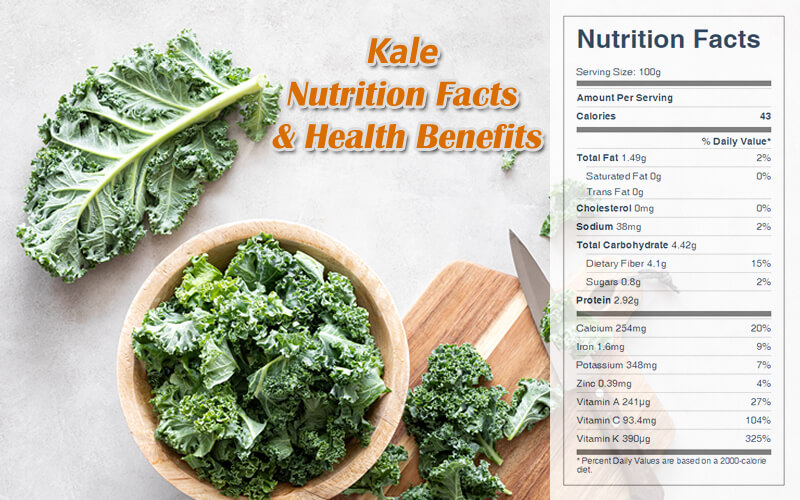Kale Nutrition Facts & Health Benefits
Kale belongs to a group of cabbage cultivars. It has become more popular as a leaf vegetable due to its nutritional value. Here are nutrition benefits of kale.

Nutritional Composition of Kale
Raw kale is composed of 84% water, 9% carbohydrates, 4% protein, and 1% fat. Raw kale provides a large amount of vitamin K and calcium. It is a rich source of vitamin A, vitamin C, vitamin B6, folate, and manganese. Kale is a good source of thiamin, riboflavin, pantothenic acid, vitamin E, and several dietary minerals, including iron, magnesium, potassium, and phosphorus.
One-half cup of cooked, chopped kale provides 21 calories, 3.7 g carbohydrate, 1.2 g protein, 0.3 g fat, 1.3 g dietary fiber, 4810 IU vitamin A, 27 mg vitamin C, 9 mcg folic acid, 148 mg potassium, 15 mg sodium, 18 mg phosphorus, 47 mg calcium, and 12 mg magnesium.
Cooked kale diminishes most of these nutrients, while values for vitamins A, C, and K, and manganese remain substantial.
Raw Kale Nutrition Facts Label
Health Benefits of Kale
Kale and collard greens are very similar, but kale often has curly leaves, and while collards thrive in a warmer climate, kale grows best in a cooler one. Both are considered warming, with a sweet, slightly bitter-pungent flavor similar to that of cabbage.
Kale is rich in the antioxidant vitamins A and C, as well as several carotenoids, including beta-carotene, lutein, and zeaxanthin. These compounds help protect vision and lower the risk of cataracts and age-related macular degeneration. It is also a good source of B vitamins, including thiamine, riboflavin, and B6, and the minerals calcium and iron. In fact, 1 cup of kale or collard greens has more calcium than 1 cup of milk.
Kale contains compounds that include polyphenols and carotenoids, contributing to its antioxidant and anti-inflammatory potential. The high presence of flavonoids (quercetin and kaempferol) and phenolic acids (caffeic, ferulic, and sinapinic acid) explains the health-promoting properties of kale. Kale contains high levels of polyphenols, such as ferulic acid, with levels varying due to environmental and genetic factors. They also contain indoles that protect against colon, breast, and lung cancer.
Most people compare kale to spinach, but kale is actually part of the Brassicaceae family (like bok choy, broccoli, and cauliflower). The key sulfur-containing compound glucosinolate found in Brassica plants is responsible for many of the health benefits of vegetables belonging to this group.
Kale is a source of the carotenoids lutein and zeaxanthin. As with broccoli and other cruciferous vegetables, kale contains glucosinolate compounds, such as glucoraphanin, which contributes to the formation of sulforaphane, a compound under preliminary research for its potential to affect human health beneficially.
A study of the bioavailability of carotenoids such as lutein and beta-carotene found in blood samples showed that lutein, betacarotene, and retinol all increased within six hours after ingestion of kale, demonstrating that kale is a good source of these carotenoids. Kale also contains higher amounts of alphatocopherol, a form of vitamin E that is considered a potent antioxidant for its ability to maintain cell membranes and prevent tissue damage.
As a dark green leafy vegetable, it is rich in vitamin K. In addition to the benefits typical of cruciferous vegetables, kale also provides a flavonoid called kaempferol that appears to reduce the risk of heart disease. Kaempferol, in combination with the flavonoids quercetin and myricetin, reduced the risk of pancreatic cancer by 23% in one 8-year study.
Kale is a superfood! It possesses key benefits for the gut as it’s considered a prebiotic food. Kale was found to have high antioxidant activity, and the seeds may hold promise for easing symptoms associated with Alzheimer’s disease. Kale seeds exhibit the ability to block acetylcholinesterase. By blocking this enzyme, it prevents the breakdown of acetylcholine. This mechanism is exactly how several drugs for Alzheimer’s disease work. Blocking the breakdown of acetylcholine results in higher concentrations of acetylcholine in the brain, which translates to better communication between nerve cells.
In addition, a study analyzed twenty-five kale genotypes and found that kale in the diet provides adequate quantities of prebiotic carbohydrates. Prebiotics are important to modify the intestinal microflora and promote the growth of beneficial bacteria. This also stimulates the immune system and promotes the absorption of vitamins and minerals.
Health Risk
Kale is high in oxalic acid, so over-consumption can cause problems for those with kidney disease, gout, vulvar pain, rheumatoid arthritis, or other conditions that may require a low-oxalate diet. Boiling can reduce the content of oxalic acid. Boiling kale decreases the level of glucosinate compounds, whereas steaming, microwaving, or stir frying does not cause significant loss.